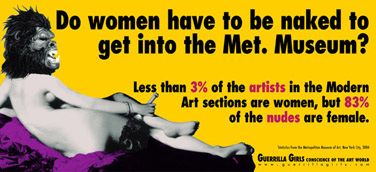The Guerrilla Girls: bringing fake fur and feminism to SHU
In 1985 a group of women artists began picketing the Museum of Modern Art (MoMA) in New York. The MoMA had professed to be the definitive survey of contemporary painting and sculpture, and only 13 of the 169 artists featured were women. But no one gave their demonstration much consideration – until they decided to throw on some “Queen Kong” masks and call themselves the “Guerrilla Girls”.
Since then they have written several books, developed over 100 posters and billboards, and traveled to places like China, Italy, Greece, Turkey, Spain, and more, to hold rallies and bring recognition and respect to women artists.
And on November 28, “Frida Kahlo,” one of the founders of the Guerrilla Girls, came to speak at Seton Hill University.
By Kayla Sawyer,
Online Editor
In 1985 a group of women artists began picketing the Museum of Modern Art (MoMA) in New York. The MoMA had professed to be the definitive survey of contemporary painting and sculpture, and only 13 of the 169 artists featured were women. But no one gave their demonstration much consideration – until they decided to throw on some “Queen Kong” masks and call themselves the “Guerrilla Girls”.
Since then they have written several books, developed over 100 posters and billboards, and traveled to places like China, Italy, Greece, Turkey, Spain, and more, to hold rallies and bring recognition and respect to women artists.
And on November 28, “Frida Kahlo,” one of the founders of the Guerrilla Girls, came to speak at Seton Hill University.
“I was so excited to see something like this come to Seton Hill’s campus,” said Meredith Harber, a senior. “Frida was hysterical and provided an excellent commentary on how women are being viewed. I particularly enjoyed seeing the various posters they made.”
“I think that having taken art history classes and being a female artist really makes me value these types of presentations,” said Jillian Kowalewski, a junior. “I also think that the humor makes the facts easier to take, but it doesn’t take away from the seriousness of the meaning behind the statistics.”
Through the use of provocative text, visuals and humor, “Kahlo’s” presentation attempted to change the image of feminism, which is frequently portrayed disparagingly.
“One of our goals has always been to change people’s minds about that ‘f’ word – ‘feminism,’“ said “Kahlo.” “We believe that feminism is a way of looking at the world. We think it’s really ridiculous that feminism is demonized in the media for so long that people who believe in the basic tenants of feminism – equal opportunity for all, equal pay for equal work, human rights for people all over the world – people will believe in those basic tenants but they’ll stop short of calling themselves ‘feminists.’ We want to change that.”
“Feminism is a much more comfortable concept to me now than it was before,” said Lauren Miller, a freshman. “I think that a lot of people are afraid to be feminists, but like Frida said, sometimes you just have to embrace it.”
All of the Guerrilla Girls are anonymous, and when asked for their names, they assume the identity of a dead female artist, thereby keeping the attention on the issues and not their personalities.
“As I tell my students, ‘One never knows where a Guerrilla Girl might be hiding in plain sight,’“ said Maureen Vissat, a professor of art history.
“We could be anyone. We’re everywhere,” said “Kahlo.” “We could be your cousin, we could be your sister, we could be your mother, we could be your grandmother, we could even be your partner.”
“It’s a shame that they must hide their identity to protect their personal lives, but it also spreads a good message: that we should focus on their cause, not their faces,” said Harber.
The Guerrilla Girls refer to themselves as the “conscience of the art world.” However, they also champion other issues, which “Kahlo” addressed in her performance. These issues include politics, female stereotyping, and the lack of women directors, writers, and Oscar winners in the film industry. Their posters about the art world, film, politics and pop culture are designed to inspire and encourage social change.
“I have always found the Guerrilla Girls to be a fascinating influence and I think having the courage to come out and say what you feel and truly believe in is important,” said Michael Pospisil, a senior.
The purpose of the Guerrilla Girls is to shock people. They want to you see, beyond the masks, that there are great women artists whose work is routinely ignored by the major art museums.
“We like to think that our work has made a big difference in the art world but old habits die hard and many museums are still lagging behind,” said “Kahlo.”
“The Guerrilla Girls are like comic book superheroes in that you don’t know their true identity. They’re fighting for their cause, and not for their own personal gain,” said Harber. “It seems a little scary to picture them sneaking around the cities at night to make posters, but after hearing Frida speak, I want to sign up!”
Photo courtesy of the Guerrilla Girls website: http://www.guerrillagirls.com/
 This poster by the Guerrilla Girls was plastered across New York City buses in 1989.
This poster by the Guerrilla Girls was plastered across New York City buses in 1989.